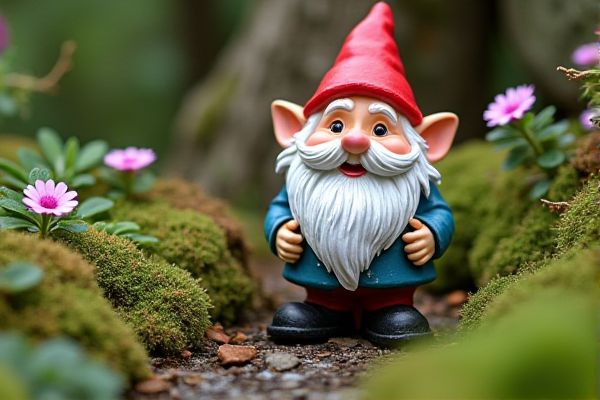
Garden gnomes bring a whimsical, rustic charm to your outdoor space with their playful, figurative designs, while fairy gardens create an enchanting miniature world filled with delicate plants and magical accessories that spark imaginative storytelling. Explore the unique features and creative possibilities of both to discover which enchanting element best suits your garden's personality.
Table of Comparison
| Feature | Garden Gnome | Fairy Garden |
|---|---|---|
| Description | Small figurine representing a gnome, often with a beard and hat. | Miniature landscape featuring fairies, plants, and tiny accessories. |
| Material | Ceramic, resin, or plastic. | Varies: plants, resin figurines, natural elements. |
| Purpose | Decorative garden ornament believed to bring protection and luck. | Decorative and imaginative small-scale garden setup promoting creativity. |
| Size | Typically 6-12 inches tall. | Varies, usually a few square feet or less. |
| Popularity | Classic and widely recognized garden accessory. | Growing trend in miniature gardening enthusiasts. |
| Setup Complexity | Simple placement in garden beds or lawns. | Requires planning, planting, and arrangement of miniature elements. |
| Maintenance | Low; occasional cleaning. | Moderate; involves plant care and upkeep of miniature features. |
Introduction to Garden Gnomes and Fairy Gardens
Garden gnomes are whimsical statues representing small humanoid creatures often placed in lawns and gardens to bring charm and folklore-inspired magic. Fairy gardens, on the other hand, are miniature landscapes designed to create an enchanting environment filled with tiny plants, fairy figurines, and decorative accessories that evoke a magical, otherworldly atmosphere. Your garden space can transform into a captivating display by choosing between the playful presence of garden gnomes or the intricate, mystical allure of fairy gardens.
Historical Origins of Garden Gnomes
Garden gnomes originated in 19th-century Germany, inspired by European folklore depicting small, bearded men as protectors of treasures and gardens. In contrast, fairy gardens draw from Celtic and British mythology, where fairies are magical, ethereal beings linked to nature and enchantment. Both garden gnomes and fairy gardens reflect cultural beliefs about guardianship and magic in outdoor spaces, rooted in ancient traditions and storytelling.
The Evolution of Fairy Gardens
Fairy gardens have evolved from simple miniature landscapes into intricate, enchanted displays featuring delicate figurines and natural elements that spark imagination and whimsy. Unlike traditional garden gnomes, which often represent protection and folklore, fairy gardens emphasize magical storytelling and personalized creativity. Your choice between a garden gnome or a fairy garden reflects a shift towards more interactive and enchanting outdoor decor that invites a sense of wonder and charm.
Design Elements: Gnome Gardens vs. Fairy Gardens
Gnome gardens typically feature rustic, earthy design elements such as moss-covered rocks, miniature mushrooms, and small animals that evoke a woodland setting, emphasizing a whimsical, robust aesthetic. Fairy gardens incorporate delicate, ethereal design elements like tiny houses with intricate detailing, pastel-colored flowers, and sparkling accents, creating an enchanting and magical atmosphere. Both garden styles use miniature figures but differ in thematic focus, with gnome gardens highlighting grounded folklore charm and fairy gardens emphasizing fantasy and lightness.
Symbolism and Cultural Significance
Garden gnomes symbolize protection and good luck, originating from European folklore where they were believed to guard treasures and homes. Fairy gardens represent enchantment and nature spirits, reflecting ancient beliefs in mystical beings that nurture plants and flowers. Your choice between a garden gnome and a fairy garden can reflect whether you prefer a guardian figure or a magical ambiance in your outdoor space.
Popular Materials and Figurines Used
Garden gnomes are commonly crafted from resin, ceramic, or concrete, featuring iconic figurines like bearded gnomes with pointy hats, tools, and animals. Fairy gardens often use materials such as polymer clay, resin, and wood, showcasing delicate fairy figurines with wings, miniature mushrooms, and tiny houses. Choosing your preferred garden decor depends on the whimsical charm you want to create, with gnomes offering a rustic feel and fairies bringing an enchanted vibe.
Creating Your Own Gnome-Inspired Garden
Create a gnome-inspired garden by incorporating whimsical garden gnome statues, vibrant flowering plants, and natural elements like stones and moss to evoke a magical woodland atmosphere. Select gnome figurines with varied poses and colors to add charm and personality, while arranging plants such as ferns, hostas, and miniature trees to complement the fairytale aesthetic. Emphasize pathways and hidden nooks to enhance exploration and create an enchanting outdoor retreat perfect for family enjoyment and relaxation.
Crafting a Magical Fairy Garden
Crafting a magical fairy garden involves selecting miniature fairy figurines, delicate plants like ferns and moss, and tiny accessories such as fairy houses and bridges to create an enchanting atmosphere. Unlike garden gnomes that offer whimsical charm with quirky statues, fairy gardens emphasize ethereal beauty and intricate, nature-inspired designs that invite imagination and storytelling. Incorporating soft lighting and natural elements enhances the mystical allure, transforming any outdoor space into a captivating fairy haven.
Gnome Gardens or Fairy Gardens: Choosing What’s Right for You
Gnome gardens offer a whimsical charm rooted in folklore, featuring stout, bearded figures that bring a rustic, playful energy to your outdoor space. Fairy gardens create an enchanting atmosphere with delicate, miniature fairy figurines and intricate accessories that inspire imagination and magic. Your choice depends on whether you prefer the earthy, grounded feel of a gnome garden or the ethereal, mystical allure of a fairy garden.
Tips for Maintaining Whimsical Garden Decor
Garden gnomes and fairy gardens require regular upkeep to maintain their charm and whimsical appeal. Use weather-resistant materials and apply protective coatings to prevent fading and damage from sunlight, rain, and frost. To keep your garden decor vibrant, clean gnomes and fairy figurines gently with a soft brush, and refresh surrounding plants with seasonal flowers that complement the magical theme.
 homyna.com
homyna.com